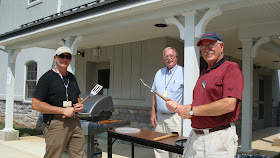In the seed saving post, below, if you enlarge the picture with the beans (by clicking on it), you’ll notice that one of the plates is labeled castor bean plant. Bill D. gave me those seeds last week at the garden tour after I admired and asked about the strange, large-leaved plants growing along the fence.
Not only are these the source of the old health tonic, castor oil, but also, the source of the deadly, full of spy-induced intrigue, compound ricin. From the Cornell site:
In 1978, ricin was used to assassinate Georgi Markov in 1978, a Bulgarian journalist who spoke out against the Bulgarian government. He was stabbed with the point of an umbrella while waiting at a bus stop near Waterloo Station in London. They found a perforated metallic pellet embedded in his leg that had presumably contained the ricin toxin.Reading that, reminded me of this NY Times article from earlier this summer, about a Brooklyn Botanic Garden exhibit dedicated to growing horrible, poisonous plants. It’s the subject of the book Wicked Plants: The Weed that Killed Lincoln's Mother & Other Botanical Atrocities, by Amy Stewart.
This passage in an interview with the author intrigued me:
Abe - Who’s going to read the book? Gardeners or people who like weird twisted stuff?I’m a gardener who also likes weird twisted stuff, so I seem to fit the demographic perfectly!
Amy Stewart - “Actually, I am really pleased to see that it’s making its way into the hands of people who like weird twisted stuff. I’m getting a lot of very, very interesting emails. There is definitely a sort of horticultural underground out there of people who are into dark and dastardly plants. But it’s also finding its way into the hands of murder mystery readers, and I love that! Those people love a good villain as much as I do!”
Any others out there? I know of at least one.
Pictures from the book here.





.jpg)

++9-1-09.JPG)





















